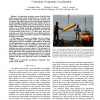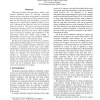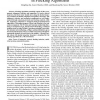720 search results - page 119 / 144 » Mobile robot navigation using sensor fusion |
ICRA
2009
IEEE
14 years 2 months ago
2009
IEEE
— In cooperative navigation, teams of mobile robots obtain range and/or angle measurements to each other and dead-reckoning information to help each other navigate more accuratel...
ICRA
2005
IEEE
14 years 1 months ago
2005
IEEE
Abstract— Mobile robots can be easily equipped with numerous sensors which can aid in the tasks of localization and ego-motion estimation. Two such examples are Inertial Measurem...
HRI
2006
ACM
14 years 1 months ago
2006
ACM
Autonomous robots use sensors to perceive and track objects in the world. Tracking algorithms use object motion models to estimate the position of a moving object. Tracking effic...
ICRA
1998
IEEE
13 years 12 months ago
1998
IEEE
1 sensors is to construct a structural description from sensor data and to match this description to a previously acquired model [Crowley 85]. An alternative is to project individu...
TFS
2008
13 years 7 months ago
2008
Abstract--Flocking algorithms essentially consist of three components: alignment, cohesion, and separation. To track a desired trajectory, the flock center should move along the de...



